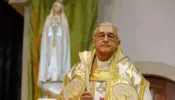Date Written: 755-725 BC
Author: Hosea, son of Beeri
Hosea's ministry began during the reign of Jeroboam II, king of Israel (786-746 BC). The exact dates of his ministry are hard to ascertain, but clearly he prophesied during the last years before the fall of the Northern Kingdom of Israel to Assyria. It was a period of affluence in Israel and many Israelites thought that the rising Assyrian power would prove to be an ally. After Jeroboam II, six kings of Israel ruled in rapid succession over a 20 year period. Four were assassinated by their successor (2 Kgs 15). At the heart of their disputes was the Assyrian issue. After a period of mixed policies, tributes and failed dealings the Assyrians defeated Israel in 722 BC and took the northern ten tribes into permanent exile and assimilation.
The Book of Hosea is a loose collection of the prophet's oracles. It consists of two main sections: Ch. 1-3 detail Hosea's relationship with his unfaithful wife Gomer and Ch. 4-14 tell of Israel's unfaithfulness to the Lord.
The Lord gives Hosea one of the most shocking commands in the Bible: Marry a prostitute! (1:2) Hosea obeys and marries Gomer and they have three children. Then she apparently returns to her immoral lifestyle, but Hosea seeks her out, redeems her and takes her back (3:2). Their relationship is meant to be a metaphor for the Lord's relationship with his people. Gomer's unfaithful character mirrors Israel's infidelity to the Lord. Even Hosea and Gomer's children represent problems in the Lord's relationship with his people (See Ch. 1). The people of Israel are in a covenant relationship with the Lord, but they have all but forgotten their commitment to him. Through Hosea, the Lord brings legally-toned accusations against them, a covenant lawsuit against his bride. Israel has committed spiritual adultery against the Lord by worshipping other gods and paying tribute to the Assyrians.
The people of Israel worshipped the Canaanite deities Baal and Asherah and participated in the sexually immoral rituals which were part of Canaanite religion. Since the time of Jeroboam I, Israelites had worshipped golden calf images in Dan and Bethel (1 Kgs 12). Hosea rejects this idolatry and calls the people to repent (Hos 8:5-6, 10:5). Menaham, king of Israel, had paid a huge tribute to the Assyrians to ward off an attack (2 Kgs 15:19). Hosea most likely is referring to this payment when he mentions Israel's submission to Assyria (5:13, 7:11, etc.). Israel had begun to trust in worldly powers instead of in the Lord. Hosea calls the people to return to the Lord and find restoration (Ch. 6, 14). In his infinite mercy, the Lord promises a future time of healing, salvation and reconciliation for his people. Though his people had been unfaithful and adulterous, he willingly extends his forgiveness and grace to them.
Hosea powerfully presents the image of the nation as the bride of the Lord. Other biblical books, such as Song of Songs, Isaiah, Revelation and the gospels, use this theme to explain the depth of God's love for his people and the gravity of breaking our relationship with him through sin. Sin separates us from God, but his mercy extends to cover us through Jesus. Hosea shows the mercy of God who welcomes back his bride after her time of unfaithfulness (3:5). The Lord's willingness to forgive his bride for her betrayal shows his willingness to forgive us for our sins. Not only does the bridal imagery show the intensity of God's desire for his people, it illustrates the extravagance of his mercy.
By Mark Giszczak











